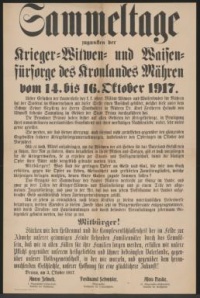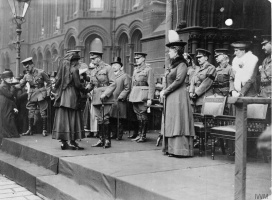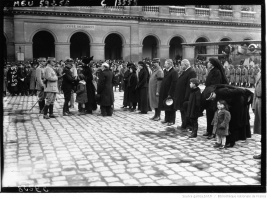Introduction↑
The total number of women widowed as a result of the First World War is estimated to be 3 to 4 million. According to the historian Jay Winter, one third of the total 9.7 million military personnel killed or missing in the war left behind, on average, a widow and two children. The number of German, British and Italian widows after the war, compared to the relative number of soldiers lost in these countries corroborates this estimate. For example, in 1920, there were 525,000 widows in Germany and 2,040,000 military men killed or missing; in Great Britain, there were 240,000 widows and 750,000 military men killed or missing; and in Italy, there were 200,000 widows and 650,000 military men killed or missing. France, on the other hand, presents an exception with the number of war widows reaching half the number of total losses: 700,000 widows and 1,400,000 military men killed or missing.
Social Conventions of Mourning↑
The conventions these women were subjected to were no different from those applying to widows in general. They had to wear mourning attire and respect a several month period of widowhood. The funeral rituals were, however, more specific to their situations, due largely to the temporary or definitive absence of a corpse. Those who did not respect these rituals or conventions ran the risk of being seen as unfaithful widows. The concept of the unfaithful widow had existed before the war, but regained popularity during the conflict due in large part to soldiers who feared being betrayed or forgotten, and moralists who saw widowed women as a possible source of social disorder that could potentially contribute to the military defeat of their respective countries.
Conventions of mourning were also affected by the different types of legislation regulating military burials within each country, which greatly affected mourning and commemoration rituals. In Britain, where there was a strict policy concerning burying fallen soldiers in situ, widows had to go abroad, whilst in Italy, France or United States, there was the possibility of recovering remains at the end of the war.
Material Support for Widows↑
The belligerent states promoted, or confirmed, legislation aimed at materially supporting war widows. Most of them granted a war pension (with a supplement for the children), although pension amounts, as well as the attribution criteria varied from one country to another. Pensions were partially or totally lost by the widows in the case of remarriage. Even in their full capacities, these pensions were insufficient to cover the daily needs of the widows, many of whom topped up their incomes by working, or relied on help from their families or new spouses. Some of the poorest widows also had recourse to charitable associations. In exchange for this help, the public powers allowed themselves to exercise fairly strong control over war widows.
Social and political control of Widows↑
War widows were restricted by considerable social and political constraints. Because of this, it is possible to infer that many women were downtrodden and easily manipulated by their governments for propaganda purposes. Speeches and pictures from the time illustrate the ambiguous position of the war widow who was expected to remain faithful to her fallen husband, whilst also contributing to the renewal of future generations for the nation.
Several studies reveal that widowed women were not only aware of their contradictory situation but also learnt, either individually or collectively, to turn these constraints to their advantage, or to challenge these constraints through their actions. In France, for example, certain widows exploited their status during the war making use of their mourning attire to encourage pacifist ideas. Although these actions were repressed by authorities during the conflict, they were rarely sanctioned afterwards. In fascist Italy, during the interwar years, many war widows resisted the mystified maternal figure created by the regime. In Germany, women artists faced with high death tolls also communicated ambivalence towards their loss. They felt unable to adhere to the figure of the patriotic women for whom loss should be worn with pride, and instead they exposed their feelings by adopting the motif of the disconsolate mourner.
Peggy Bette, Université Rennes 2
Section Editor: Emmanuelle Cronier
Selected Bibliography
- Bette, Peggy: Veuves françaises de la Première Guerre mondiale. Statuts, itinéraires et combats, thesis, Lyon 2012: Université Lyon 2.
- Kuhlman, Erika A.: Of little comfort. War widows, fallen soldiers, and the remaking of nation after the Great War, New York 2012: New York University Press.
- Lomas, Janis: 'Delicate duties'. Issues of class and respectability in government policy towards the wives and widows of British soldiers in the era of the Great War, in: Women's History Review 9/1, 2000, pp. 123-147.
- Siebrecht, Claudia: The aesthetics of loss. German women's art of the First World War, Oxford 2013: Oxford University Press.
- Wingenter, Anne M.: Le veterane del Dolore. Mothers and widows of the "fallen" in fascist Italy, thesis, Chicago 2003: Loyola University of Chicago.
- Winter, Jay: Sites of memory, sites of mourning. The Great War in European cultural history, Cambridge 2000: Cambridge University Press.










